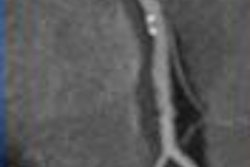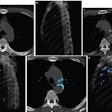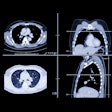Prospects for a formal screening role for virtual colonoscopy (VC or CT colonography [CTC]) saw a major boost today following the decision by the American Cancer Society (ACS) to add the study to its five-year colon screening guidelines.
VC joins colonoscopy (recommended every 10 years), flexible sigmoidoscopy (every five years), double contrast barium enema (every five years), annual guaiac fecal occult blood testing (gFOBT), and annual fecal immunochemical test (FIT) as accepted testing options in the ACS guidelines for the early detection of colorectal cancer. Stool DNA testing has also been added.
The guidelines, Screening and Surveillance for the Early Detection of Colorectal Cancer and Adenomatous Polyps, 2008, were jointly released by the ACS, the U.S. Multi-Society Task Force on Colorectal Cancer, and the American College of Radiology (ACR).
Since 2003, the ACS had considered VC to be promising, but lacking sufficient evidence to recommend its inclusion in the screening protocol. The society now chose to add VC to the guidelines, citing recent data that suggest CTC is comparable to optical colonoscopy for detecting cancer and polyps of significant size when state-of-the-art techniques are applied.
"Provided that advanced, proven techniques are employed in the clinical setting, CTC is included in the guidelines as an option for colorectal cancer screening and prevention in average-risk adults age 50 years and older," the ACS said.
The news builds on VC's momentum established by a bevy of positive clinical studies in recent months, including the National CT Colonography Trial (ACRIN 6664), research from the University of Wisconsin Medical School in Madison published in the New England Journal of Medicine, the IMPACT trial from Italy, and the Munich Colorectal Cancer Prevention Trial.
As the ACS is the leading authority on cancer screening and prevention, its blessing should result in broad acceptance for CT colonography screening, said Dr. Perry Pickhardt, an associate professor from the University of Wisconsin Medical School.
"This exciting development should lead to widespread reimbursement for CTC screening by third-party payors, which is the final remaining barrier to actual large-scale implementation throughout the U.S.," Pickhardt said.
These new guidelines not only reflect endorsement for CTC screening by the ACS and the ACR, but also by the three major gastrointestinal societies: the American Gastroenterological Association (AGA), the American Society for Gastrointestinal Endoscopy (AGSE), and the American College of Gastroenterology (ACG). This collaborative spirit should lead to increased screening compliance, Pickhardt said.
The new guidelines represent a tremendous victory of collaborative effort between the radiology and gastroenterology societies under the direction of the ACS, echoed Dr. Beth McFarland, chair of the ACR's colon cancer committee. Objective and effective multidisciplinary collaborations such as these are essential for appropriate implementation of emerging technologies, she said.
This year will be a turning-point year for CT colonography, she told AuntMinnie.com.
"After the successful results of ACRIN and other large trial results are published, the transition into practice will be greatly aided by the quality metrics being defined by the ACR to ensure high-quality examinations," she said.
In other changes to the guidelines, screening tests have been grouped into two categories based on performance characteristics: tests that detect adenomatous polyps and cancer, and tests that primarily detect cancer. Flexible sigmoidoscopy, colonoscopy, double-contrast barium enema, and CT colonography were included in the first category, while annual gFOBT, FIT, and stool DNA testing were placed in the second category.
"It is the strong opinion of the expert panel that colon cancer prevention should be the primary goal of colorectal cancer screening," the guidelines stated. "Exams that are designed to detect both early cancer and precancerous polyps should be encouraged if resources are available and patients are willing to undergo an invasive test."
The updated guidelines also established a sensitivity threshold for recommended tests.
"All screening tests should have evidence in the medical literature documenting their ability to detect the majority of cancers present at the time of testing," the guidelines stated. "Tests which do not meet this standard should not be used."
In the past, the society's guidelines for the early detection of colorectal cancer have emphasized options, and will continue to do so to enhance access to and uptake of screening, according to the ACS.
"The society maintains that the best test is the one you get that is done well," the ACS said.
By Erik L. Ridley
AuntMinnie.com staff writer
March 5, 2008
Related Reading
Accuracy of polyp measurements depends on CT values, February 21, 2008
Bill introduced to add VC to Medicare screening coverage, December 20, 2007
VC CAD beats human readers in multicenter trial data, November 19, 2007
Five-modality Munich trial finds high sensitivity for OC, VC, November 12, 2007
Positive trial results boost VC's prospects for broader screening role, October 16, 2007
Copyright © 2008 AuntMinnie.com



















